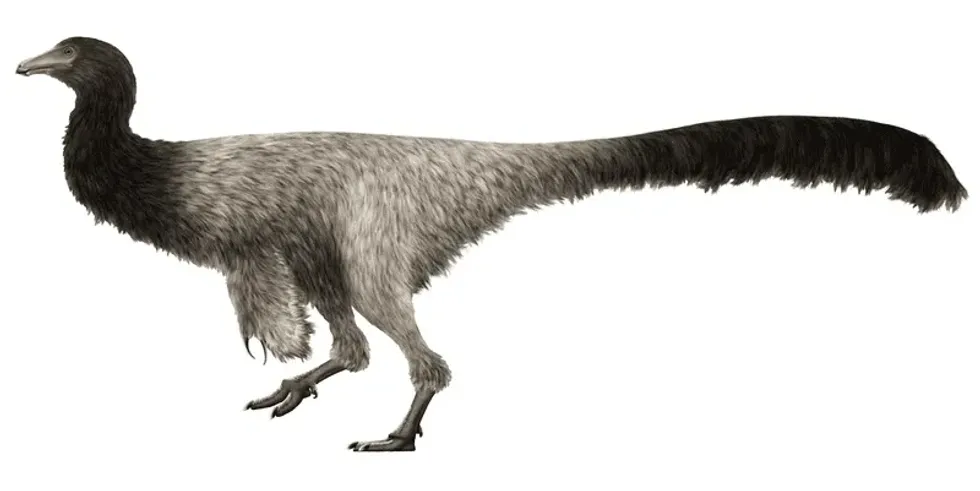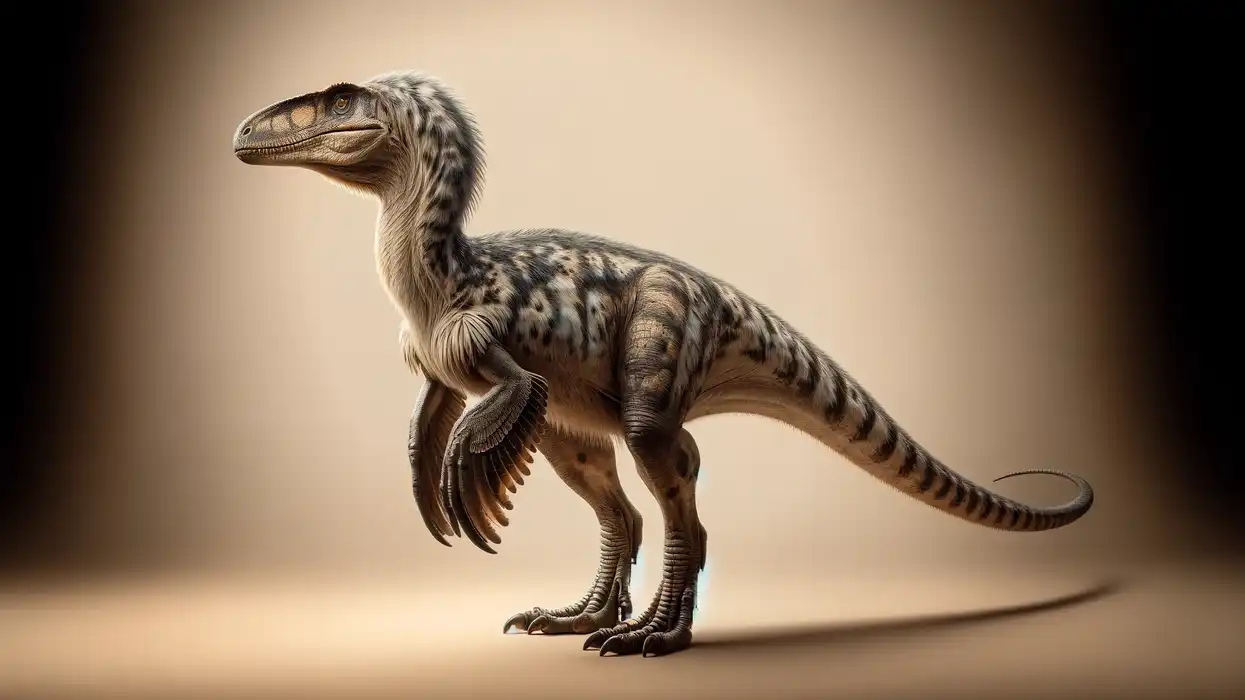Garudimimus (G. brevipes) dinosaur is a genus of ornithomimosaurs that lived in Mongolia during the Late Cretaceous period. In a joint Soviet-Mongolian paleontological expedition in 1981, their fossil specimen was found in the Upper Cretaceous Bayan Shireh Formation.
The Garudimimus brevipes was formally described in the same year by Rinchen Barsbold. This dinosaur was an ornithomimosaur and was a primitive ornithomimid.
However, unlike other primitive ornithomimosaurs, these carnivorous dinosaurs had some missing pieces in their nearly completed skeleton.
This complete and articulated skeleton had the skull but lacked certain parts like the pectoral girdle, forelimbs, and posterior caudal vertebrae. The lateral surfaces of the vertebrae lacked air spaces.
Its back surface was concave and wide. The skull has straight upper and lower jaws which were both without teeth.
Unlike other ornithomimosaurs, it had small hip bones and short legs. The muscles were also not very well developed. This has led to a theory that these dinosaurs of Mongolia might have been quite slow for an ornithomimosaur species.
Again, some scientists believe that the skull had a small horn at the top which might have broken loose. The specimen, today, is usually seen as the only known Garudimimus fossil, though Philip J. Currie, a well-known scientist, argued that another part of an arctometatarsalian material belonged to Garudimimus.
The skeleton of these carnivorous dinosaurs was, for the first time, described in detail by Yoshitsugu Kobayashi Barsbold Rinchen around 2004-05.
Kobayashi and Barsboldv R. noted that this taxon shared traits with the primitive ornithomimosaurs such as feet with four toes and toothless jaws. The study of this evolutionary relationship put Ornithomimidae as the sister taxon of this carnivorous dinosaur.
These dinosaurs were often found in habitats like wetlands, forests, shorelines, and their terrestrial habitat was shared with animals like monkeys, snakes, lions, and other terrestrial animals. Continue reading the article to know more interesting facts about Garudimimus.
If you'd like to learn more about similar dinosaurs, check out our other article about Incisivosaurus fun facts for kids or Atrociraptor interesting facts for kids!
Garudimimus Interesting Facts
How do you pronounce 'Garudimimus'?
This Theropoda dinosaur's name is pronounced as 'Ga-roo-dee-meem-us'. Described in detail by Kobayashi and Barsbold R., they were of great length and had an omnivorous diet. The almost complete skeleton of this animal lacked a pectoral girdle, forelimbs, and caudal vertebrae at the back.
What type of dinosaur was a Garudimimus?
This dinosaur, which roamed the earth during the Late Cretaceous Period in Mongolia, was a large theropod that belongs to the Theropoda subgroup. The Grudimimus (G. brevipes) fossil was discovered in the Baynshiree Formation, Upper Cretaceous, at the Baishin Tsav locality in Mongolia.
In which geological period did Garudimimus roam the earth?
These carnivorous dinosaurs were believed to have lived during the Late Cretaceous period in Mongolia about 123 million years ago.
When did Garudimimus become extinct?
The Garudimimus became extinct about 65 million years ago and their fossils were found in Mongolia.
Where did Garudimimus live?
This dinosaur of great length, which was initially described by Barsbold R., lived in terrestrial habitats. They made their homes in wetlands, forests, grasslands, caves, and so on. Since the exact age of the Baynshiree Formation is not known, through research, they are believed to have lived in both the Cenomanian and Campanian periods of the Late Cretaceous.
What was the Garudimimus' habitat?
Garudidmus (G. brevipes) dinosaurs lived in habitats like wetlands, forests, grasslands, caves, and so on. The fossil of the original specimen was located in the Baynshiree Formation in Mongolia.
Who did Garudimimus live with?
It was believed by scientists that these dinosaurs were of great length and lived in the Cretaceous of Mongolia, would have possibly been solitary and lone individuals, feeding on carcasses and moving from one habitat to another!
How long did a Garudimimus live?
It is not known how long these carnivorous dinosaurs lived for, but being dinosaurs they would have almost certainly lived for more than 100 years.
How did they reproduce?
Reproduction among these dinosaurs, whose fossils were located at the Baynshiree Formation at the Baishin Tsav locality Mongolia, was largely oviparous. This means that they laid eggs that were incubated by the female dinosaur. Very little is known about the parental care they would have given the young but the young became independent quite early.
Garudimimus Fun Facts
What did Garudimimus look like?

This carnivorous dinosaur, from the Late Cretaceous period in Mongolia, was a small and early ornithomimosaurian that was not adapted to be as fast as other ornithomimids. Their nearly complete skeleton lacked forelimbs, caudal vertebrae at the back, and a pectoral girdle.
Scientific research has stated that these animals had a toothless skull, short legs, feet that were heavy, and short hip bones.
The lateral surfaces of the vertebrae lacked air spaces.
Since these features were not well-developed like other ornithomimosaurs, it indicated that they were not really efficient runners. The foot of this dinosaur consisted of four toes unlike other ornithomimids, consisting of a part on the first digit that is considered to be irrelevant now due to the effects of evolution.
Early re-examinations of the skeleton also suggested that they might have had a horn but it was declared recently that it was only a broken piece of the skull. Yoshitsugu Kobayashi had stated that the original description provided by Richen Barsbold was very correct in explanation as well as in the description.
Down the years, Philip J. Curie stated that a part of the Archaeornithomimus remains belonged to the Garudimimus.
How many bones did a Garudimimus have?
The number of bones that these dinosaurs, whose fossils were discovered in a joint Soviet-Mongolian expedition, have is not known at the moment. However, since they come from the dinosaur species, they would have definitely had more than 200 bones!
The lateral surface of the vertebrae lacked air spaces and Kobayashi's colleague, Phillip J. Currie concluded from research that a piece of the Archaeornithomimus matter belonged to the Garudimimus.
How did they communicate?
Being dinosaurs, they would have communicated with each other using vocal and visual displays. Loud calls, growls, roars, and using elements of the environment around them like water and trees would be examples of how these dinosaurs of Mongolia, whose Theropoda skeleton was found at Baishin Tsav in Mongolia, would have communicated with each other.
How big was the Garudimimus?
From studying the original specimen, the Garudimimus was quite small. They were roughly about 138-157 in (350.5-398.7 cm) in length, about the same length as brown bears!
How fast could a Garudimimus move?
From studying their short leg and hip features, paleontologists concluded that these dinosaurs were not very good or quick with their movement. The lateral surfaces of the vertebrae lacked air spaces.
This could have been because they had a slightly big and rounded body that did not allow them to move fast with their short legs. This was surprising for researchers to learn because normally, derived ornithomimids had a great speed!
How much did a Garudimimus weigh?
The Garudimimus dinosaur weighed about 216 lb (98 kg), about the same as a black bear!
What were the male and female names of the species?
These dinosaur species, whose fossils were found in the Baynshiree Formation, do not have sex-specific male or female names.
What would you call a baby Garudimimus?
A baby Garudimimus, like all other dinosaur babies, is called a hatchling or a nestling! These young dinosaurs are believed to have become quite independent at an early stage.
What did they eat?
These dinosaurs were carnivores, feeding on the carcasses of small rabbits, fish, small deers, and birds like chickens or turkeys.
How aggressive were they?
Like all dinosaur species, these dinosaurs of Mongolia would have shown aggression to each other to a certain degree in situations where they were either provoked or threatened by other animals. However, these dinosaurs were not necessarily violent with each other.
Did you know...
The generic name combines a reference to the Garuda, winged creatures from Mongolian-Buddhist mythology, with a Latin mimus, 'mimic'. The particular name is derived from Latin brevis-'short', and pes-'foot', referring to the short metatarsus.
Why are they called Garudimimus?
In reference to Hindu mythology, this dinosaur was named after the Garuda bird and so the name Garudimimus stuck with the dinosaur. Its name literally translated to 'short-footed Garuda mimic'.
How strong were Garudimimus' teeth?
The skull of this Dinosauria was found to be toothless so it was difficult for scientists, to determine how strong they were. However, the teeth of this 'garuda mimic' would have been quite strong given the fact that they were carnivores!
Here at Kidadl, we have carefully created lots of interesting family-friendly dinosaur facts for everyone to discover! Learn more about some other creatures from our Prosaurolophus fun facts, or Ostafrikasaurus interesting facts for kids.
You can even occupy yourself at home by coloring in one of our free printable Garudimimus coloring pages.
Main image by Paleo Neolitic.










